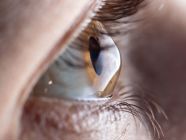It’s often believed that treating lazy eye is only possible during childhood, and that the chance of recovery fades with age. While it’s true that early intervention—especially before age seven—is most effective due to the brain’s flexibility at that stage, recent research shows this belief isn’t entirely accurate. Science is increasingly proving that the brain’s plasticity goes beyond expectations, opening new opportunities to treat lazy eye even in adults. (2)
What Is Lazy Eye?
Lazy eye, or amblyopia, is a condition in which one eye is weaker than the other due to improper visual development in early childhood. In this case, the brain gradually stops processing input from the weaker eye, favoring the stronger one instead. (3)
It typically begins in childhood, often affecting one eye, though in rare cases it may affect both. Lazy eye is treatable when diagnosed early, significantly reducing the risk of long-term vision loss or blindness. However, treatment becomes more difficult and less effective in adulthood. (3)
Can Lazy Eye Be Treated in Adults?
Although treatment is more effective when started early, recent studies by the National Eye Institute (NEI) have shown that older children and teens up to age 17 can still achieve improvements in vision, and that treatment may make a difference at any age.
For adults, treatment is generally less effective due to reduced brain plasticity, but new approaches such as vision therapy and computer-based visual training are being explored, with some potential to improve vision to a limited degree.
If left untreated, the condition may worsen over time, but even modest improvements in vision can be achieved through proper treatment. (4)
What Treatment Options Are Available?
Modern therapies like computer-based vision therapy and virtual reality (VR) games have shown effectiveness in improving vision in many adults with amblyopia. Even traditional treatments can offer some level of improvement. (5)
Here are the common treatment options for lazy eye in adults: (5)
1. Prescription Glasses
These help correct vision imbalances and encourage the brain to use the weaker eye more actively.
2. Visual Exercises
These include structured activities to enhance focus, eye muscle strength, and coordination between both eyes and the brain. Often, patching is used during these exercises to maximize the effect on the weaker eye. (2)
3. Computer-Based and Virtual Reality Vision Therapy
One of the latest treatments, this method uses specialized software or VR games to stimulate the weaker eye. During therapy, the image seen by the stronger eye is dimmed or blurred, while the weaker eye sees a clearer image. This forces the brain to use both eyes together, enhancing the function of the weaker eye over time. (6)
Can Laser or LASIK Treat Lazy Eye?
Laser eye surgeries like LASIK do not directly correct lazy eye, but they may help treat accompanying vision issues such as refractive errors. (5)
Conclusion
Lazy eye treatment can significantly improve quality of life—even beyond the age when treatment is thought to be most effective. While it may require strong motivation and patience, the results can be worthwhile.
If you’re interested in exploring treatment options, visit the Ophthalmology Department at Al-Ahli Hospital to learn more and receive expert care.
References:
- Mayo Clinic -Lazy eye (amblyopia)
- Verywell Health - Lazy Eye: Causes and Treatment
- NEI - Amblyopia (Lazy Eye)
- NLM - Standard Amblyopia Therapy in Adults with Longstanding Amblyopia Improves Visual Acuity and Contrast Sensitivity
- Cleveland Clinic - When Is It Too Late To Treat Lazy Eye?
- BYNOCS - Dichoptic therapy for Amblyopia or lazy eye






